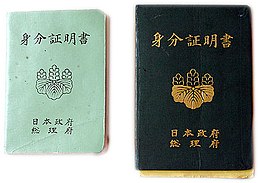|
Mainland Japan
"Mainland Japan" (内地, naichi, lit. "inner lands") is a term used to distinguish Japan's core land area from its outlying territories. It is most commonly used to distinguish the country's four largest islands (Hokkaidō, Honshū, Kyūshū, and Shikokū) from smaller islands such as the Bonin Islands and the Ryukyu Islands. However, depending on the context, the term "Mainland Japan" may refer only to Honshū, the largest island. The term's literal Japanese meaning might best be translated as "inner Japan" or "inner lands". The term "mainland" is somewhat inaccurate since it usually refers to all or part of a continental landmass, rather than islands. "Mainland Japan" was an official term in the pre-war period, distinguishing Japan proper from its colonies in the Far East (which at that time included parts of mainland Asia). After the end of World War II its usage became less common and lost its previous legal significance. Historical usageIn the Japanese Empire of the pre-war period, naichi referred to the mainland of the empire. The other territories of the empire was called gaichi (外地, lit. "outer lands"). The Meiji Constitution's Article 1 of the Common Law (共通法) enumerates the territories with legal jurisdictions namely: NaichiNaichi (内地, lit. "inner lands") referred to the territories under direct control of the government. They consisted of the following:[1]
GaichiThese territories were called gaichi (外地, lit. "outer lands"). They were part of the Empire of Japan, but not under direct control by the central government.
Although it has never been abolished, the Common Law lost effect from enforcement after Japan lost all the former colonies, or gaichi as a result of World War II.[citation needed] Modern usageResidents of places like Hokkaidō, Okinawa and Amami occasionally use naichi to refer to the "mainland", excluding these areas. The colloquial usage is officially "incorrect", as both areas are legally within naichi. In Hokkaidō, the official term that refers to Japan except Hokkaidō is dōgai (lit. outside of Hokkaidō).[citation needed] With dōgai becoming common even in colloquial use, naichi ceased to be used.[citation needed] Residents of Okinawa also use the term hondo (lit. mainland) to refer to parts of Japan outside of Okinawa. In Japanese law, the meaning of hondo is used to make a distinction between the "main islands" of Hokkaidō, Honshū, Shikoku, and Kyūshū and "outlying islands" referred to as ritō.[3] The term "main islands" (本島 hontō) is used for Hokkaido, Honshu, Kyushu, Shikoku and Okinawa. The other estimated 6,847 smaller islands are called 'remote islands' (離島 ritō).[4] See alsoReferences
|
||||||||||||||

